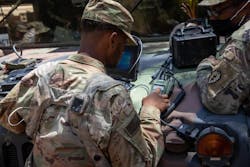Air Force researchers ask industry for network security in tactical networking and secure data movement
ROME, N.Y. – U.S. Air Force researchers are asking industry for ways to enhance information sharing flexibility at the tactical edge and enable secure information movement and network security across different security domains in air, space, and ground applications.
Officials of the Air Force Research Laboratory's Information Directorate in Rome, N.Y., issued a broad agency announcement (FA8750-24-S-7002) for the Networking the Fight project.
This secure tactical networking project seeks secure data movement across "red-black" boundaries, spanning heterogeneous networks to strengthen information sharing and collaboration in tactical environments.
The project will involve rapidly integrating a modeling and simulation framework to provide field testable prototypes in next generation cross domain solution broker; dynamic red/black networking; and modeling, simulation, and analysis.
Related: Data storage making the transition to network-based systems
Today's tactical networking architectures are not well suited for timely movement of critical mission data across security domains and networks at the tactical edge.
Cross domain solutions typically require enterprise reach-back to handle complex mission data, dynamic changes in policy, and several security domains, and mission data cannot be re-routed dynamically in-mission and lack resiliency in degraded networks.
The future fight will require interoperability across all operating domains and require a cohesive infrastructure, and requires a transition from today's pre-planned information transport across kill-chains to realize the future's resilient, dynamic, ad-hoc information transport across kill-webs.
Related: Secure data storage for battlefield networking
Networking the Fight has three technical areas. First is next-generation cross domain solution broker that provides a discoverable, reconfigurable cross-domain solution framework that meets throughput and latency requirements for tactical deployment at scale and supporting network quality of service.
Second is dynamic red/black networking, which will provide the ability to pass metadata from the red side to the black side enabling the black network to make routing decisions and provide resilient forwarding over black networks.
Third is modeling, simulation, and analysis, which establishes a non-proprietary multi-vendor modeling, simulation, and analysis testbed focused on digital models for the first two technical areas.
Related: Military cyber security: threats and solutions
Networking the Fight will be open until 14 Feb. 2029, and first will accepted white papers by 28 Feb. 2024. Several contract awards are expected.
Companies interested should email white papers to Air Force Capt. Niko Petrocelli at [email protected]. Those submitting promising white papers will be invited to submit full proposals.
Email technical questions or concerns to Petrocelli, and business questions to the Air Force's Amber Buckley at [email protected]. More information is online at https://www.fbodaily.com/archive/2024/02-February/23-Feb-2024/FBO-06971776.htm.
